Health
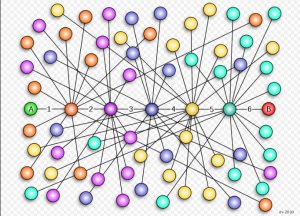 I’m sure that most you have heard of the theory of Six Degrees of Separation, but in case you haven’t, it is the idea that all living things and everything else in the world are six or fewer steps away from each other, so that a chain of “a friend of a friend” statements can be made to connect any two people in a maximum of six steps. I can’t say that I have ever doubted that idea, but I really never gave it much thought really. The idea was originally set out by Frigyes Karinthy in 1929 and popularized in an eponymous 1990 play written by John Guare. It is sometimes generalized to the average social distance being logarithmic in the size of the population. It is all about what a small world it is. That each person is connected to every other person by just 6 steps. It was something I never have given much thought to.
I’m sure that most you have heard of the theory of Six Degrees of Separation, but in case you haven’t, it is the idea that all living things and everything else in the world are six or fewer steps away from each other, so that a chain of “a friend of a friend” statements can be made to connect any two people in a maximum of six steps. I can’t say that I have ever doubted that idea, but I really never gave it much thought really. The idea was originally set out by Frigyes Karinthy in 1929 and popularized in an eponymous 1990 play written by John Guare. It is sometimes generalized to the average social distance being logarithmic in the size of the population. It is all about what a small world it is. That each person is connected to every other person by just 6 steps. It was something I never have given much thought to.
As I became interested in family history, I could see how that could work in the grand scheme of things, with relation. I came across people who were related to me, as well as, being related to my husband. Those relationships had meaning to me and it also made me think about the six degrees of separation that I had heard about years before.
But the reality is that the six degrees of separation never became so obvious to me as last Sunday when my husband had a heart attack. Instantly, we had a group of people around us. Of those people, all concerned for my husband, I knew no one. I only knew that the two women were nurses, and there was a young man who had seen my husband fall. Somewhere in the parking lot was also a woman who knew she needed to pray for him. When we left for the hospital in the ambulance, I thanked the man from across the distance between us in the parking lot, but I still didn’t know his name. I had no idea how I would ever find out who these people were. I knew they were all heroes, and I didn’t know them. Then the six degrees of separation came into play.
First, my husband was saved, and that was a miracle. It was because of 4 people I not only didn’t know, but had now way of finding. They did what they needed to do, and left expecting nothing in return. We owed them so much, and had no way to thank them. Enter the six degrees of separation. I told my husband’s nurse about what had happened, and when her relief came on the next day, she told her about it, and Stephanie, the day nurse already had the first connection for us. The first nurse to help, Ginger, was her sister. And Ginger had the second connection, because she knew the second nurse, Val. Within a few hours, 2 out of the 4 were now known to us. When when I posted about my husband’s miraculous recovery, our friend, Sierra Schamber tagged someone. It was Sean, the young man who helped him first. Then, a woman named Chelsea called her dad to pray. My boss called a prayer partner, who just happened to be on the wife of Chelsea’s dad. I know all those heroes. I think I fully understand the six degrees of separation.
 As a Christian, I can tell you that I believe in miracles. Nevertheless, I am still trying to wrap my mind around the awesomeness of God. Seriously, can any of us really wrap our mind around that? I think that the mind boggling, realization of the always loving God we serve is, never more prominent than when he reaches down, in our worst moment, and lifts us up, dries our eyes, and gives us instant peace.
As a Christian, I can tell you that I believe in miracles. Nevertheless, I am still trying to wrap my mind around the awesomeness of God. Seriously, can any of us really wrap our mind around that? I think that the mind boggling, realization of the always loving God we serve is, never more prominent than when he reaches down, in our worst moment, and lifts us up, dries our eyes, and gives us instant peace.
That moment came for me on Sunday afternoon, October 14, 2018, in the Walmart parking lot on the east side of Casper, Wyoming at 4:45pm. Some things you never forget, although I might be a few minutes off on the exact time. My husband, Bob Schulenberg and I had just finished buying groceries, and had loaded them in the car. Bob took the cart back to the cart station, and I opened the car and started it. Then, I looked at my phone, because Bob is a very social man, and almost always finds someone to talk to, no matter where we are.
I then heard a man, I now know to be Sean Pesicka-Taggart saying, “Sir…Sir?” I looked back and saw him kneeling near the back of my car, but there was a pickup right behind me, and it appeared that they were talking, so I did not get out of my car. The pickup, that I now know was driven by a Wyoming Medical Center, Progressive Care Unit, cardiac care nurse…Ginger Sims, pulled around the corner very quickly, and I thought she must be mad. Before I had time to contemplate that thought, a man knocked on my window and asked, “Do you know this guy?” It occurred to me that “this guy” must be Bob, so I jumped out of my car and went to the back of the car. The scene that met me there was…horrifying!! There lay Bob, blood flowing from his head where he had hit the pavement. While that would have been enough to bring fear to my heart, one look at his face told an even worse story. His eyes were blank and his skin had started turning blue. It looked as if he was dead, and that was my first thought…”I’m going to lose him right here!!” Then, I jolted my mind back to fight mode, and got down next to him and began talking to him.
At this point, nurse Ginger was behind him with her stethoscope…who has their stethoscope when they are off duty?? Thankfully Ginger does. Because she didn’t see him fall, she thought he had been hit by a car. She asked him to take a deep breath and when he didn’t respond, she asked if he could hear her, while checking for a pulse. Upon finding no pulse, she immediately got him on his back and began CPR. Working alone for a while, a WMC transport worker, Laura Lance spelled her doing CPR. Then, Wyoming Medical Center, surgical nurse…Val Boycheva, who was a friend of Ginger’s came on the scene and they worked together. When they heard me say Bob’s name, they asked if I knew him. When I said that he was my husband, they asked me to do rescue breathing. I did it…with instruction. I don’t think I could have done it without them telling me what to do…I was far too shook up to think straight.
As the CPR was going on, Sean was on the phone getting an ambulance, and Ginger had already told her son to 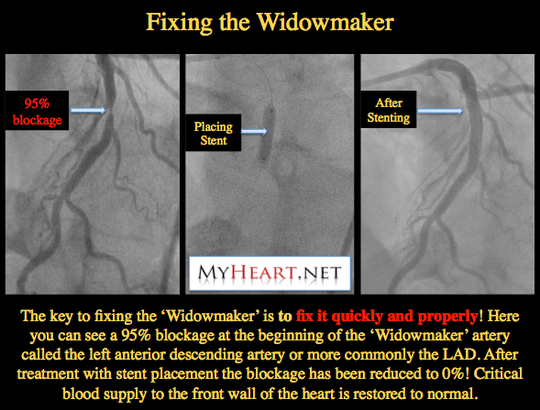 push the OnStar button to give the ambulance driver the exact location. When the ambulance arrived, they took over, and the police officer, also at the scene asked who I was. When I said I was his wife, he had me come over and give him some information. While doing that, the ambulance crew hooked Bob up to the Lucas Compression Devise, and when I turned around, it was engaged. If you have never seen the Lucas Compression Devise in action, all I can say is that it is a shock to watch…especially when it is on your loved one. The devise gives perfectly orchestrated compressions, so the ambulance crew can focus on other tasks. To the untrained spectator, it looks like those compressions are going from chest to pavement!! You can imagine breaking ribs and smashed organs, but in reality, while the ribs are cracked, the heart is simply given the right amount of compression to help sustain life. Bob was quickly prepared for the ride in the ambulance to the hospital where he received the best care available.
push the OnStar button to give the ambulance driver the exact location. When the ambulance arrived, they took over, and the police officer, also at the scene asked who I was. When I said I was his wife, he had me come over and give him some information. While doing that, the ambulance crew hooked Bob up to the Lucas Compression Devise, and when I turned around, it was engaged. If you have never seen the Lucas Compression Devise in action, all I can say is that it is a shock to watch…especially when it is on your loved one. The devise gives perfectly orchestrated compressions, so the ambulance crew can focus on other tasks. To the untrained spectator, it looks like those compressions are going from chest to pavement!! You can imagine breaking ribs and smashed organs, but in reality, while the ribs are cracked, the heart is simply given the right amount of compression to help sustain life. Bob was quickly prepared for the ride in the ambulance to the hospital where he received the best care available.
It was at this moment that Casper Fire Department firefighter, Jerod Levin, who is a friend of Bob’s from his time as Fire Department Mechanic for the City of Casper, saw me. He knew me as well, and immediately came to me and gave me the big hug that I desperately needed at that exact moment. For all firefighters…never underestimate the value of your hugs at an emergency medical scene. When the ambulance leaves with the love one, that person is left with serious emotions and doubts. Your hugs and encouraging words mean more than you will ever know. No matter what the outcome, those hugs and words of encouragement are vital. Jerod asked me if I wanted to ride in the ambulance, and I said that I did. He got me in, even holding my purse while I stepped in, then helped me get buckled, asked if he could call anyone for me, and if I wanted him to bring my car to the hospital. Talk about going above and beyond!! While en route to the hospital, Bob’s heart had to be shocked once, and when we arrived he was in full arrest. I didn’t know it at the time, but that almost always means bad news.
Bob was treated so quickly that it was almost shocking. He was taken for a CT scan of his head wound, and while there, the Cath Lab became available. He was taken directly up there, where he was met by two techs that he knew, because he has worked on their cars. Jon Cooke and Sam Cann made him feel comfortable and safe during the procedure. They determined where the blockage was, at which time they realized that he was going to survive the Widowmaker Heart Attack. A stent was placed and from the time he fell to the time the treatment was over was two hours. Two hours!! That is an amazingly short amount of time.
Unbeknownst to me, there was at least one person who saw what was going on and called her dad to have him pray with her over the man who fell in the Walmart parking lot. When I called my boss, Jim Stengel, he felt led to call his prayer partners, Donna and “Page” LePage to pray with them. The girl, Chelsea Kessler, who was with her husband Zachary, who called her dad was Page’s daughter, and they were praying as Donna and Jim prayed. It is my belief that nothing happens by chance in this world. God is always involved, and if people listen, they can find themselves in just the right place to be part of a miracle. The two nurses almost never shop at Walmart, and yet both were there on that day at that time. The young man who saw my husband fall immediately 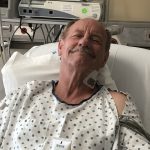 thought that if it were his grandfather, he would want someone to help him, so he acted. Each of these people acted in a way that put them becoming God’s hands on this earth. Bob had angels watching over him, and a family who pray for him all the time. When he had a need, God was there to meet the need, and His people, who hear His voice, did what He told them to do, and in the end they were a part of a miracle. In just under two days, Bob was released from the hospital, and his life goes on. Then I found out at church that another church member, Lori Desanti was also praying. Every prayer, and every player in this was necessary, and I want to thank each and every one of those people who helped us. We can never repay your kindness. And I give all praise to our Awesome God!!
thought that if it were his grandfather, he would want someone to help him, so he acted. Each of these people acted in a way that put them becoming God’s hands on this earth. Bob had angels watching over him, and a family who pray for him all the time. When he had a need, God was there to meet the need, and His people, who hear His voice, did what He told them to do, and in the end they were a part of a miracle. In just under two days, Bob was released from the hospital, and his life goes on. Then I found out at church that another church member, Lori Desanti was also praying. Every prayer, and every player in this was necessary, and I want to thank each and every one of those people who helped us. We can never repay your kindness. And I give all praise to our Awesome God!!
 Some people always have a calm look on their face, even if they are not smiling, they somehow manage not to be frowning. Things don’t really work that way for the concentrator…which is what I am. Concentrators tend to have a frown on their face, so people might think they are mad, when in fact, they are not. They might not have even noticed that anyone is looking at them, much less smiling at them. At least not until that person says something to them or writes them a note saying, of all things, “You really should smile!” For the concentrator, there is really no bigger insult. Maybe the person who said it, meant no harm, but if they thought about it, there are much nicer ways to get someone to smile.
Some people always have a calm look on their face, even if they are not smiling, they somehow manage not to be frowning. Things don’t really work that way for the concentrator…which is what I am. Concentrators tend to have a frown on their face, so people might think they are mad, when in fact, they are not. They might not have even noticed that anyone is looking at them, much less smiling at them. At least not until that person says something to them or writes them a note saying, of all things, “You really should smile!” For the concentrator, there is really no bigger insult. Maybe the person who said it, meant no harm, but if they thought about it, there are much nicer ways to get someone to smile.
In fact, the other day, while I was driving down second street in Casper, Wyoming, I saw a young man walking down the street. It was not a warm day, and the young man was bundled up in a coat and hat, but even with the distinct chill, to put it mildly, the young man has a smile on his face as he walked along. He wasn’t on the phone, or walking with someone else, and he wasn’t talking, so I could see no specific reason for the smile on his face.
I wondered what he was thinking about that would put a smile on his face. It didn’t matter really, because I smiled instinctively, because he was smiling. It didn’t matter what he was smiling about, his smile made me smile. It was sort of like the movie, Pay It Forward, except with smiles. I though about what a nice young man he might be, but whether I was right or not, didn’t make any difference. His smile told a tale all its own. A tale of Smiling it forward. It sounds silly, but that is what that young man did. His smile brought a smile to my face, and perhaps my smile brought a smile to the face of someone else, and so on…smiling it forward.
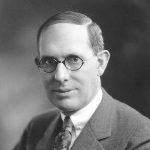 When the automobile first came out, driving them safely wasn’t the only difficulty. The early years of the automobile, found drivers using iron hand cranks to start the internal combustion process that powered the engines on their cars. Getting them started took great hand and arm strength, and the system was not without certain risks. Drivers who forgot to turn the ignition off before turning the crank, could be surprised when the car backfired or rolled forward. You may not know it, but at that time most vehicles had no brakes. Clearly a better system was needed, and in 1911 Cadillac head Henry M Leland gave Charles F Kettering the task of developing one. Kettering was the co-founder of Dayton Engineering Laboratories Company (DELCO) in Dayton, Ohio.
When the automobile first came out, driving them safely wasn’t the only difficulty. The early years of the automobile, found drivers using iron hand cranks to start the internal combustion process that powered the engines on their cars. Getting them started took great hand and arm strength, and the system was not without certain risks. Drivers who forgot to turn the ignition off before turning the crank, could be surprised when the car backfired or rolled forward. You may not know it, but at that time most vehicles had no brakes. Clearly a better system was needed, and in 1911 Cadillac head Henry M Leland gave Charles F Kettering the task of developing one. Kettering was the co-founder of Dayton Engineering Laboratories Company (DELCO) in Dayton, Ohio.
Before founding DELCO with his partner Edward Deeds in 1909, Kettering worked at the National Cash Register Company. While there, he helped develop the first electric cash register. I’m sure that was what called attention to him when Leland was looking for the right inventor for his project. Kettering drew on his experience with the cash register, when approaching his work with automobiles. The new invention wasn’t that big a leap from the cash register either. Just as the touch of a button had started a motor that opened the drawer of the cash register, Kettering would eventually use a key to turn on his self-starting motor. The self-starter was introduced in the 1912 Cadillac, patented by Kettering in 1915, when he was issued U.S. Patent No. 1,150,523 for his “engine-starting device,” the first electric ignition device for automobiles, on August 17, 1915.
The device worked so well that by the 1920s, it would come standard on nearly every new automobile. The device made cars easier and safer to operate, especially for women. The new self-starting engine was a huge hit, and caused a big jump in sales. The new engine was responsible for the fast-growing automobile culture in America. United Motors Corporation, which would become General Motors, bought DELCO in 1916. Kettering was the vice president and director of research at GM from 1920 to 1947. The self-starting engine wasn’t the only invention Kettering headed-up. Other important auto-related innovations developed during Kettering’s 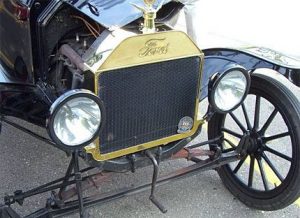 tenure were quick-drying automotive paint, spark plugs, leaded gasoline, shock absorbers, the automatic transmission, four-wheel brakes, the diesel engine and safety glass. He helped develop the refrigerant Freon, used in refrigerators and air conditioners, and the Kettering home in Dayton was the first in the country to be air-conditioned. In the realm of medicine, Kettering created a treatment for venereal disease and an incubator for premature infants, and in 1945 he and longtime General Motors head Alfred P Sloan established the Sloan-Kettering Institute for Cancer Research in New York City. Charles F Kettering died in 1958, having made great contributions toward the improvement of many lives.
tenure were quick-drying automotive paint, spark plugs, leaded gasoline, shock absorbers, the automatic transmission, four-wheel brakes, the diesel engine and safety glass. He helped develop the refrigerant Freon, used in refrigerators and air conditioners, and the Kettering home in Dayton was the first in the country to be air-conditioned. In the realm of medicine, Kettering created a treatment for venereal disease and an incubator for premature infants, and in 1945 he and longtime General Motors head Alfred P Sloan established the Sloan-Kettering Institute for Cancer Research in New York City. Charles F Kettering died in 1958, having made great contributions toward the improvement of many lives.
 My nephew, Dave Balcerzak married my niece, Chantel in June of 2002, but they had known each other since childhood. We all loved Dave from the beginning. He is a big teddy bear, who doesn’t have a mean bone in his body. He fit into the family instantly, and we have all been so pleased to have him in the family. Dave is a man of considerable technical talent, and has been there for those of us who have been in need of repairs on computers, but that is the least of the reasons that we love Dave. When he married my niece, Chantel, Dave became Dad to her kids, Jake Harman and
My nephew, Dave Balcerzak married my niece, Chantel in June of 2002, but they had known each other since childhood. We all loved Dave from the beginning. He is a big teddy bear, who doesn’t have a mean bone in his body. He fit into the family instantly, and we have all been so pleased to have him in the family. Dave is a man of considerable technical talent, and has been there for those of us who have been in need of repairs on computers, but that is the least of the reasons that we love Dave. When he married my niece, Chantel, Dave became Dad to her kids, Jake Harman and 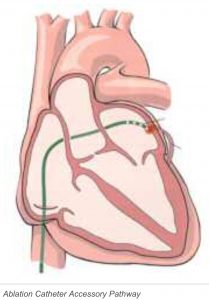 Siara Harman Olsen. He was the only dad they really ever had, even though they had a dad. Dave was there for the long haul. He didn’t leave when the going got rough. He was there when there were tears and broken hearts, and through the difficult teenage years, and it was Dave who was their dad at their weddings, who walked Siara down the isle. Dave is the man they call Dad, because he is the man who has been their dad, and dad to his own two kids, Keifer Balcerzak and Katy Balcerzak Collett. Dave is a dad at heart. He was the dad that he should be for his kids, and the dad he didn’t have to be for Chantel’s kids. And now he is grandpa to the four grandchildren they have given them.
Siara Harman Olsen. He was the only dad they really ever had, even though they had a dad. Dave was there for the long haul. He didn’t leave when the going got rough. He was there when there were tears and broken hearts, and through the difficult teenage years, and it was Dave who was their dad at their weddings, who walked Siara down the isle. Dave is the man they call Dad, because he is the man who has been their dad, and dad to his own two kids, Keifer Balcerzak and Katy Balcerzak Collett. Dave is a dad at heart. He was the dad that he should be for his kids, and the dad he didn’t have to be for Chantel’s kids. And now he is grandpa to the four grandchildren they have given them.
A few months ago, Dave had some health problems that put him in the hospital with 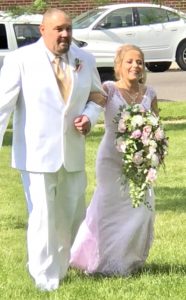 heart problems. While there, he had a stroke. That was really the beginning of a miracle for Dave. Miraculously, a CNA quickly caught that something wasn’t right. All Dave said was that his big toe hurt, but she saw so much more. Dave was quickly treated for a stroke, and then for an irregular heartbeat, that was the cause of the stroke. They tried shocking his heart, but the rhythm wouldn’t hold. Finally, they did a Catheter Ablation procedure. Basically it is a procedure that destroys the area of the heart muscle that is causing the arrhythmias. It sounds like a drastic measure to fix arrhythmia in the heart, but it worked. Within a couple of weeks, Dave was back to normal, and able to walk Siara down the isle at her wedding. It was a miraculous moment, and one he wasn’t sure was going to happen. He would not have had the stamina to do that had his heart not been repaired. Once again, Dave was able to be the dad, he didn’t have to be, but chose to be. Today is Dave’s birthday. Happy birthday Dave!! We give thanks to God that you are still here with us. Have a great day!! We love you!!
heart problems. While there, he had a stroke. That was really the beginning of a miracle for Dave. Miraculously, a CNA quickly caught that something wasn’t right. All Dave said was that his big toe hurt, but she saw so much more. Dave was quickly treated for a stroke, and then for an irregular heartbeat, that was the cause of the stroke. They tried shocking his heart, but the rhythm wouldn’t hold. Finally, they did a Catheter Ablation procedure. Basically it is a procedure that destroys the area of the heart muscle that is causing the arrhythmias. It sounds like a drastic measure to fix arrhythmia in the heart, but it worked. Within a couple of weeks, Dave was back to normal, and able to walk Siara down the isle at her wedding. It was a miraculous moment, and one he wasn’t sure was going to happen. He would not have had the stamina to do that had his heart not been repaired. Once again, Dave was able to be the dad, he didn’t have to be, but chose to be. Today is Dave’s birthday. Happy birthday Dave!! We give thanks to God that you are still here with us. Have a great day!! We love you!!
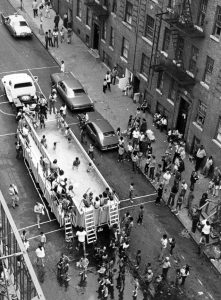 New York City can get hot in the summer. Maybe that is an understatement. I don’t think that New York City has more heat waves than other places, but because of so much asphalt, the heat is in the air, and then radiates back up from the streets again and again. Heat waves like this can not only make people sick, but they can kill people as well. Sometimes, desperate times bring desperate measures. Bathhouses, beaches, community pools, floating pools docked off the East River, all in an effort to cool off the overheated people. Nobody can say that New York City made no effort over the years to keep residents cool on hot summer days, but what of those who couldn’t get to the places set up too cool the the people off. Something had to be done. Enter the Swimmobile.
New York City can get hot in the summer. Maybe that is an understatement. I don’t think that New York City has more heat waves than other places, but because of so much asphalt, the heat is in the air, and then radiates back up from the streets again and again. Heat waves like this can not only make people sick, but they can kill people as well. Sometimes, desperate times bring desperate measures. Bathhouses, beaches, community pools, floating pools docked off the East River, all in an effort to cool off the overheated people. Nobody can say that New York City made no effort over the years to keep residents cool on hot summer days, but what of those who couldn’t get to the places set up too cool the the people off. Something had to be done. Enter the Swimmobile.
In the crisis, New York City decided to bring the pool to the people. These were the Swimmobile pools. They were attached to a truck, which could be parked on a street all day and conveniently towed away at night. “Swimmobiles began during the Heckscher administration [1960s-1970s] that literally took pools to the streets to underserved areas,” says the Parks Department website. It was more that trying to give more people the right to go swimming…this was life and death. A 1976 New York Times article stated that the city owned five mobile pools, which were towed from Randall’s Island to different corners of the city. These Swimmobiles Probably saved countless lives, and the people had fun too.
These past couple of days have brought temperatures in the high 90s and low 100s to Casper, Wyoming, where 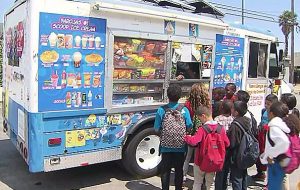 I live, and were it not for air conditioning, I would most likely be screaming for a Swimmobile myself, but I’m quite certain, none would be found. These were something that served its purpose in a time of need, and then went the way of most things when technology advances things…into the past. These days, when we are hit with a heatwave, people drive to the pools, lakes, or rivers…or they simply turn on the air conditioner, or if there happens to be an ice cream truck in the area, we can always indulge in some cold treats, as a way to cool off. Of course, if there is a power blackout, they would have to come up with another solution, as ice cream would not hold out long. Thankfully, outages don’t last too long, most of the time, or we might have to bring back the Swimmobile.
I live, and were it not for air conditioning, I would most likely be screaming for a Swimmobile myself, but I’m quite certain, none would be found. These were something that served its purpose in a time of need, and then went the way of most things when technology advances things…into the past. These days, when we are hit with a heatwave, people drive to the pools, lakes, or rivers…or they simply turn on the air conditioner, or if there happens to be an ice cream truck in the area, we can always indulge in some cold treats, as a way to cool off. Of course, if there is a power blackout, they would have to come up with another solution, as ice cream would not hold out long. Thankfully, outages don’t last too long, most of the time, or we might have to bring back the Swimmobile.
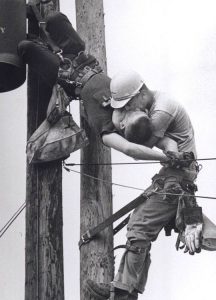 It’s every workers nightmare…being faced with a life or death situation involving a co-worker, and you are the only thing standing between the co-worker and certain death. On a hot July day in Florida in 1967, a nightmare emergency situation would unfold making linemen history, and journalistic history at the same time.
It’s every workers nightmare…being faced with a life or death situation involving a co-worker, and you are the only thing standing between the co-worker and certain death. On a hot July day in Florida in 1967, a nightmare emergency situation would unfold making linemen history, and journalistic history at the same time.
Rocco Morabito was a journalist with the Jacksonville Journal. His day began as he was headed to a local news event. He paused to watch as linemen worked above him, before heading on to his job for the day, covering a railroad strike. H snapped a few images and then headed back to the office, but as he passed the linemen, he heard screaming. Looking up, he saw Randall G. Champion, unconscious, his body hanging limp but still in his safety harness. Fellow lineman, J. D. Thompson was an apprentice lineman, but in a nightmare emergency moment, he sprang into action with lightening speed, racing to the pole and quickly climbing up to Champion. The position of Champion’s body made it impossible to administer CPR, so Thompson cradled his head in his arm and began giving mouth-to-mouth resuscitation, working to breath life back into his fellow lineman. His quick thinking and actions, made Thompson a hero that day.
Being a photojournalist, Rocco instinctively snapped an image and then ran to his car, to use the radio to have the paper call an ambulance. In reality, Champion would owe his life to both men, because they both reacted quickly and did what needed to get done to get Champion the help he needed. Unable to further assist with the rescue, Rocco grabbed his camera. He backed up and continued to walk backward until he backed into a house. With no where else to go, he clicked “THE historic image.” As he snapped that last photo, Thompson yelled out, “He’s Breathing!”
After Rocco ‘got the shot’, he returned to his car and again radioed the newspaper dispatch, this time, telling them, ”You might want to wait for this. I think I’ve got a pretty good one.” The paper waited, and the wait was indeed worth it. Rocco Morabito won the 1968 Pulitzer Prize for Spot Photography…the first of its kind. Bob Pate, the copy editor of the Jacksonville Journal is credited with the ‘slug that stuck’, ”The Kiss of Life.” From safety classes to anthologies, and even a documentary in 2008 on the 40th anniversary of that fateful event, the photo has maintained a life of its own. When I saw it, I was as moved by it as anyone else who has ever seen it and been told what it was. You just don’t walk away from that without having a sense of awe about the events of that day. And the training value of it would be phenomenal!!
Champion and Thompson both continued to work as linemen until retirement. Champion retired in 1991, but sadly passed away in 2002 at the age of 64, as a result of heart failure. Thompson retired around 1995 having received several awards for his heroism and quick thinking. He is noted as having said that, “he was acting on his training and was thankful he could revive his downed co-worker.” He was just “doing his job.” What?? I don’t think so!! This was not just doing his job. This was heroic. That is typical of most heroes. They were “just doing their job.” Rocco worked for the newspaper for a total of 42 years. For 33 of those years, he worked as a photographer. He retired in 1982, and passed away at the age of 88 on April 5, 2009. His work, including “The Kiss of Life”, will continue to live on, illustrating the harrowing work that our linemen men and women perform every day, and sometimes just how heroic they really are.
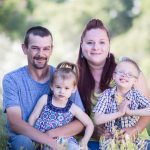
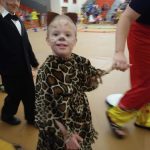 As with all children, it’s hard to believe that my grand-nephew, Lucas Iverson is 7 years old today. With Lucas, it might be a little harder to believe than most kids, in fact. Lucas was born with Down Syndrome, but that has been the least of his problems. Lucas has been plagued with a number of health problems that have required multiple surgeries. In fact, according to his mom, Cassie Iverson, Lucas has had more surgeries than he has had years. I’m sure there are those who have had more surgeries, but no matter how you look at it, that is a lot of surgeries for a little guy. Since Lucas’ last birthday, he has had to make trips to Children’s Hospital in Aurora, Colorado, every two weeks, with intestinal and immune system issues, typical of Down Syndrome. Now that he has had multiple surgeries, he is better, and they can breathe a little easier where his health is concerned.
As with all children, it’s hard to believe that my grand-nephew, Lucas Iverson is 7 years old today. With Lucas, it might be a little harder to believe than most kids, in fact. Lucas was born with Down Syndrome, but that has been the least of his problems. Lucas has been plagued with a number of health problems that have required multiple surgeries. In fact, according to his mom, Cassie Iverson, Lucas has had more surgeries than he has had years. I’m sure there are those who have had more surgeries, but no matter how you look at it, that is a lot of surgeries for a little guy. Since Lucas’ last birthday, he has had to make trips to Children’s Hospital in Aurora, Colorado, every two weeks, with intestinal and immune system issues, typical of Down Syndrome. Now that he has had multiple surgeries, he is better, and they can breathe a little easier where his health is concerned.
Lucas was in Kindergarten this last year, and in their Kindergarten Circus, Lucas got to be a wild cat. I’m not sure how wild is, but I prefer to think of him as a lion, because he is brave and strong…and a fighter. To me that is exactly what Lucas is…a fighter…strong, brave, and fierce. Lucas likes school, with his special needs, he has his own personal teacher. That is really a good thing, and maybe a little unusual in a small town like Powell, Wyoming. Lucas’ parents have considered moving to Colorado or Tennessee, because of so many good opportunities and closer healthcare for Lucas, but the thought of them moving has been a very difficult one for their families, so for now, they will stay in Powell. Of course, the hope is that Lucas will not need any more surgeries in the future. He has really been through enough, if you ask me.
Down Syndrome children often have poor muscle tone, and they have to work very hard to learn to do the things we all take for granted. Right now, in his physical therapy,Lucas is working on jumping. He also loves 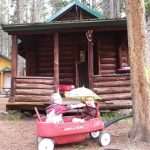
 rolling on the big ball as he phases off with his feet. I think Lucas has one other ace in the hole…his little sister, Zoey, who dearly loves her big brother, and has been instrumental in many of his abilities. She is patient and encouraging, and doesn’t leave him behind, just because he is slower. Zoey is Lucas’ best friend. They love to go camping with their parents, Chris and Cassie. They gt out is the outdoors where they can get some brain boosting and immune system boosting dirt in their hands. Today is Lucas’ 7th birthday. Happy birthday Lucas!! Have a great day!! We love you!!
rolling on the big ball as he phases off with his feet. I think Lucas has one other ace in the hole…his little sister, Zoey, who dearly loves her big brother, and has been instrumental in many of his abilities. She is patient and encouraging, and doesn’t leave him behind, just because he is slower. Zoey is Lucas’ best friend. They love to go camping with their parents, Chris and Cassie. They gt out is the outdoors where they can get some brain boosting and immune system boosting dirt in their hands. Today is Lucas’ 7th birthday. Happy birthday Lucas!! Have a great day!! We love you!!
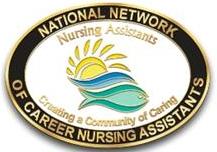 Since I was a caregiver for 13 years before the passing of the last of my parents and in-laws early in January of this year, I can tell you that being a caregiver, or a CNA is a big job that often gets very little recognition. Many people don’t really have any desire to do such a job, but because they remain in caregiving positions, Career Nursing Assistants provide predictability and stability to care, which in turn enhances the feeling of security for our aging, frail, or chronically challenged population. CNAs also bring wisdom, patience, humor, and a general attitude of caring to the daily lives of the residents in their care.
Since I was a caregiver for 13 years before the passing of the last of my parents and in-laws early in January of this year, I can tell you that being a caregiver, or a CNA is a big job that often gets very little recognition. Many people don’t really have any desire to do such a job, but because they remain in caregiving positions, Career Nursing Assistants provide predictability and stability to care, which in turn enhances the feeling of security for our aging, frail, or chronically challenged population. CNAs also bring wisdom, patience, humor, and a general attitude of caring to the daily lives of the residents in their care.
Today is National Career Nursing Assistants Day. It is a day founded by the National Network of Career Nursing Assistants to promote recognition, education, research, advocacy and peer support development for nursing assistants in nursing homes and other long-term care settings. This is especially close to my heart for a number of reasons, such as the care given to my parents and in-law, but 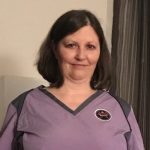 most recently because my daughter, Corrie Petersen is now a CNA working toward her degree as a nurse. She currently works at Elkhorn Rehabilitation Hospital in Casper, Wyoming, and we couldn’t be more proud of her. Having been a caregiver, I can tell you that the work that CNAs do is vital to the well-being of their patients, whether in a nursing home facility, a physical therapy facility (which is where my daughter works), at the patient’s home, or in hospice facilities.
most recently because my daughter, Corrie Petersen is now a CNA working toward her degree as a nurse. She currently works at Elkhorn Rehabilitation Hospital in Casper, Wyoming, and we couldn’t be more proud of her. Having been a caregiver, I can tell you that the work that CNAs do is vital to the well-being of their patients, whether in a nursing home facility, a physical therapy facility (which is where my daughter works), at the patient’s home, or in hospice facilities.
According to the National Network of Career Nursing Assistants, “Nursing Assistants are the best thing about ‘caring.'” Nursing Assistants “Brighten Lives” according to Dawn Silva, CNA, New Hampshire, and member “Safe Patient Handling” committee. As more and more people are living longer, caring for the elderly has become more and more vital. With that care comes an increased focus on the people who care for the elderly…largely 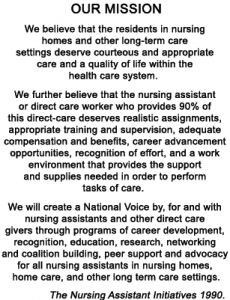 nurses and CNAs. It’s a noble occupation. While the work is hard, and what some might consider demeaning, the sense of peace it gives the patients makes being a CNA worth it.
nurses and CNAs. It’s a noble occupation. While the work is hard, and what some might consider demeaning, the sense of peace it gives the patients makes being a CNA worth it.
Every CNA is a blessing to those they care for and the nursing staff they work with. They support the facility they work in and the patients they care for. They bring a smile to the faces of their patients, and the patients are grateful for the help they receive. I don’t know of a facility out there that could run effectively without its CNAs, and I know how hard it is when a facility is shorthanded on CNAs. It makes everything harder for everyone working there, and especially harder on the patients who depend on them every day. Today is National Career Nursing Assistants Day. I am very proud of my daughter, Corrie Petersen, and of all the other CNAs I know. Thank you all for the work you do. Have a wonderful day, each and every one of you!! Happy National Career Nursing Assistants Day!!
 My sister-in-law, Brenda Schulenberg became quite ill a number of years ago, and finally had to face the fact that her weight was slowly killing her. I suppose some people might think that statement is harsh, but they don’t know my sister-in-law. Those were fighting words for her, or at least a call to action. When she found out that her weight had caused sleep apnea and congestive heart failure, she decided that she was not going to let her weight win. From that day forward, the world would see a new Brenda…a determined Brenda.
My sister-in-law, Brenda Schulenberg became quite ill a number of years ago, and finally had to face the fact that her weight was slowly killing her. I suppose some people might think that statement is harsh, but they don’t know my sister-in-law. Those were fighting words for her, or at least a call to action. When she found out that her weight had caused sleep apnea and congestive heart failure, she decided that she was not going to let her weight win. From that day forward, the world would see a new Brenda…a determined Brenda.
The road was long, and filled with hard work. Brenda doggedly walked in the cold early morning hours, rain or shine, and even in snow. She bought a bicycle, and fought hard 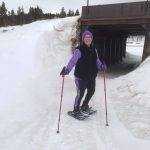 to master that skill again, even with knees that had to be retrained to bent enough to work the pedals. In fact, when she started, Brenda had to take the pedals off and strider the bike (basically run while seated on a bicycle). It was work, but she wanted to ride a bicycle again, and determination goes a long way toward success. These days Brenda can be found riding her bicycle most days at some point in the day. She loves the Platte River Trail, and often rides its entire length.
to master that skill again, even with knees that had to be retrained to bent enough to work the pedals. In fact, when she started, Brenda had to take the pedals off and strider the bike (basically run while seated on a bicycle). It was work, but she wanted to ride a bicycle again, and determination goes a long way toward success. These days Brenda can be found riding her bicycle most days at some point in the day. She loves the Platte River Trail, and often rides its entire length.
Not only has Brenda continued to follow her own health and fitness plan, but she has chosen to mentor others. She has made several trips to attend meetings in other towns to talk to their weight loss groups, even if they are not on Weight Watchers, like 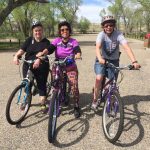 she is. She has put her name out there as someone who will buddy up with people who are struggling to lose weight to see if she can be on any encouragement or assistance. She is willing to go out and walk with them or ride bicycles with them too. She is so adamant about health, that she doesn’t want anyone to struggle with their health. I guess that since she has been on the unhealthy side of life, and the healthy side of life, and has chosen the healthy side of life, she wants others to be able to experience just how great it feels to be healthy…and she wants to help them to achieve their own health and fitness goals that have seemed so impossible to them. It is a noble calling. Today is Brenda’s birthday. Happy birthday Brenda!! Have a great day!! We love you!!
she is. She has put her name out there as someone who will buddy up with people who are struggling to lose weight to see if she can be on any encouragement or assistance. She is willing to go out and walk with them or ride bicycles with them too. She is so adamant about health, that she doesn’t want anyone to struggle with their health. I guess that since she has been on the unhealthy side of life, and the healthy side of life, and has chosen the healthy side of life, she wants others to be able to experience just how great it feels to be healthy…and she wants to help them to achieve their own health and fitness goals that have seemed so impossible to them. It is a noble calling. Today is Brenda’s birthday. Happy birthday Brenda!! Have a great day!! We love you!!

